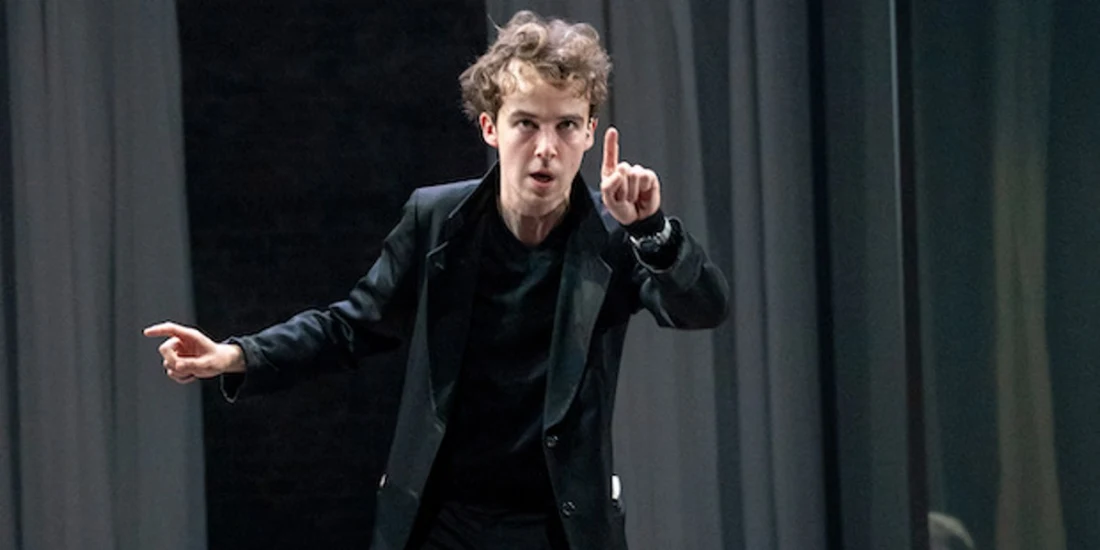'Hamlet' review — classic play holds a mirror up to today
The expansive new production of Hamlet at Park Avenue Armory opens with screens. Horatio, Bernardo, and Francisco see the ghost of the recently dead King Hamlet not in person, but through a feed of security cameras, the images warping as the king flashes in and out. This gigantic screen — and the others on either side of the stage and throughout the house — brings home that this Hamlet is about surveillance. The characters are always being watched, by the cameras, by each other. And when you are always expected to put on a performance, what happens when the lines between pretend and the truth blurs? Therein lies madness.
Robert Icke's 3.5-hour contemporary production of Hamlet played to critical acclaim in the West End (with Fleabag's hot priest Andrew Scott as the Danish prince). It has transferred to New York City with a mixture of old and new cast members. Crucially, its Hamlet is new and painfully young: 27-year-old Alex Lawther (of The Imitation Game).
Lawther plays Hamlet not as a world-wise adult overcome by vengeance, but as a boyish man who is feeling too much at once: grief, disappointment, betrayal, anger, loneliness. And he has no outlet for any of those feelings. Lawther's depiction of Hamlet is similar to Marcel Spears in Fat Ham, another superlative contemporary adaptation of Hamlet currently running at the Public Theater.
That surfeit of feeling means that when Hamlet comes home to Denmark to find that his mother Gertrude has quickly married his uncle Claudius after King Hamlet's death, Gertrude saying, "All that lives must die. Passing through nature to eternity," is not a throwaway line. Hamlet is obviously overcome with grief — he wears black and doesn't participate in the wedding festivities — but no one actually sits down with him and helps him process his pain. Instead, they all talk about him and spy on him, treating Hamlet as a problem to be solved rather than a person in need of guidance.
Thus Icke's production brings home the true tragedy of the play: It's not the failed revenge plot; it's the lack of communication. It's the notion that watching someone means we know them. The only time Hamlet freely speaks is when he directly addresses the audience. Lawther delivers Hamlet's lines slowly to the audience, in a melancholy, as if he's thinking of them in the moment. But when the moment of revelation hits him, such as in the line, "The play's the thing, wherein I'll catch the conscience of the king!", it inspires the audience to applaud.
At the same time, the play doesn't ask us to completely sympathize with Hamlet. In the "get thee to a nunnery" scene with Ophelia (a luminous Kirsty Rider), he doesn't just shout it. Hamlet physically assaults her — Rider's mic was off, but I could clearly hear her shout, "Stop!" It's a distressing moment that might have been needlessly provocative if not for the clarity behind Icke's intent: Hamlet's grief infects everything around him. When Hamlet brandishes a gun in the latter half of the play, it brings to mind the angry young men in countless news headlines with no outlet for their feelings aside from violence. "I must be cruel, only to be kind," isn't just a statement here. It's a threat.
Just as Hamlet is not a clear hero, there are no clear villains. Jennifer Ehle's Gertrude and Angus Wright's Claudius are a couple very much in love — in the play's early scenes, they can hardly keep their hands off each other. This makes their hasty marriage understandable: Claudius is portrayed as a gentler figure, while Gertrude contains equal parts maternal tenderness and strength. When Claudius says, "This is the poison of deep grief" in reference to Hamlet's behavior, he isn't deflecting; he has a point. You get the sense that if these characters just talked to each other, a lot of pain and death could be avoided.
The modern-day set for this Hamlet is expansive, with set and costumes by Hildegard Bechtler (though the characters look less like modern royals and more like rich Upper West Siders). The set is large but mostly spare, aside from large glass windows and a pair of Scandinavian-style couches and those giant screens. The vastness of the stage underscores the distance between the characters, and they are many times separated by a glass wall. The metaphor is obvious but effective.
The production also uses the music of Bob Dylan throughout. Hamlet was supposed to play in New York in 2020 at the same time as another Dylan-inspired show from the U.K.: the jukebox musical Girl From the North Country. In Hamlet, there's an obvious use of Dylan's "All Along the Watchtower" to soundtrack some war footage, but otherwise, Dylan's ballads ground the production. Despite all the video cameras and the stylish set, this Hamlet carries a contemporary message about the importance of human connection, and how disconnecting from each other can bring deadly consequences.
Hamlet is at Park Avenue Armory through August 13. Get Hamlet tickets on New York Theatre Guide.
Photo credit: Alex Lawther in Hamlet. (Photo by Stephanie Berger)
Originally published on
